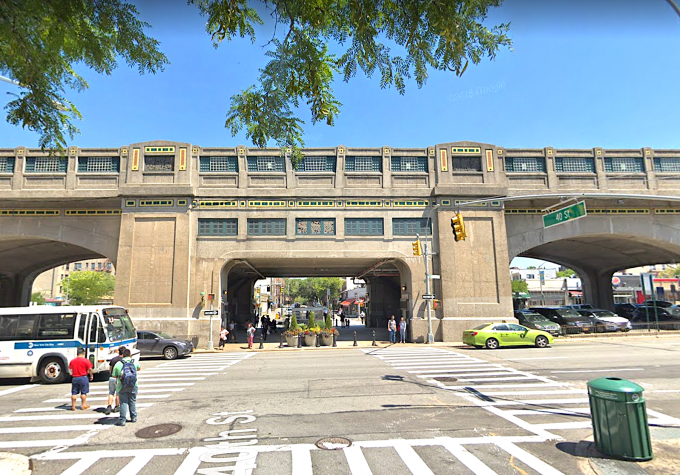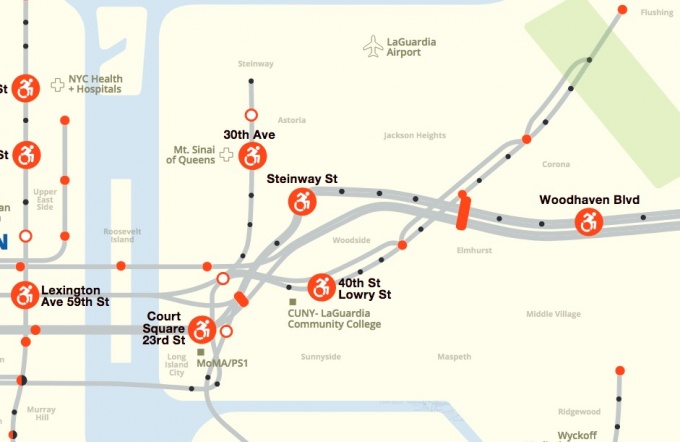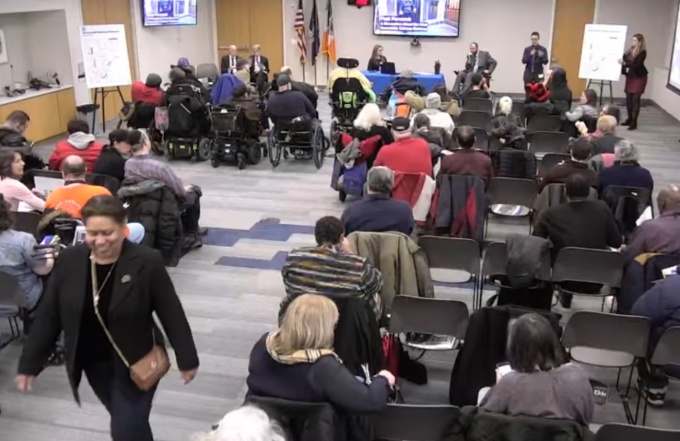
40 St – Lowery St Station. (Google Maps)
Feb. 20, 2019 By Nathaly Pesantez
A new map recently put forth by a public transit nonprofit outlines dozens of subway stations the Metropolitan Transportation Authority should focus on making fully accessible, with Sunnyside’s 40th Street-Lowery Street station among the selected.
The map, released late last month by the TransitCenter and titled “Access2024,” highlights 50 stations in the five boroughs that, if enhanced with elevators and ADA accessibility within the next five years, “would greatly increase the travel ability of riders with limited mobility,” according to the group.
The five-year mark for the station improvements is a nod to the MTA’s ambitious Fast Forward plan unveiled last year by Andy Byford, the new New York City Transit president, that aims to make 50 stations in the system accessible by the 2024 time frame so that riders are no more than two stops away from an ADA station. The entire system would also become accessible by 2034 under the plan.
While the MTA has yet to select the target stations, and with the Fast Forward plan (which lists accessibility as one of four pillars to concentrate modernization on) yet to receive funding commitments, the TransitCenter has moved forward and released its own list of priority stations in hopes of keeping the pressure on the plan’s implementation.

Part of the TransitCenter’s Access2024 map, showing the 40th Street station and other proposed ADA stations in Queens. Black dots represent inaccessible stations, red dots show accessible stops. The white dots outlined in red show stations the MTA is working to make accessible. (TransitCenter)
The stations on the list were either selected to maximize subway access in neighborhoods with high populations of people with disabilities; to better connect to major destinations; and to make for better connection points between the bus and subway. The criteria closely follows the MTA’s own guidelines for the next ADA stations, but does not factor other items on the agency’s radar, like cost and project complexity.
Locations were also chosen in collaboration with other transit advocacy groups and disability rights organizations.
The 40th Street station, according to Colin Wright, senior advocacy associate at the TransitCenter, is located in an area that hits much of the outlined criteria.
A significant number of Access-A-Ride users, based on MTA data, use the paratransit service near the station, Wright said. The station is also located near several destination points, like LaGuardia Community College, with a student body of about 50,000, and Sunnyside Community Services, which houses a senior citizen center.
The station, according to MTA data from 2017, was also the 158th most busiest in the subway system, Wright added, putting it in the top 33 percent of most trafficked stations across the city.
To make the station fully accessible would also address the dearth of accessibility along the line in Sunnyside alone.
“You look at the 7 line, and there’s plenty of geographical area to cover where there’s no accessible station,” Wright said, adding, “There’s a large gap right there in Sunnyside.”
The five stations on the line between the Court Square and Woodside – 61 Street stops are inaccessible. Even then, only the 7 line is accessible at the Court Square stop, despite the E, G and M stopping at the station.
ADA upgrades to the G line at the Court Square station, however, are in progress. Queensboro Plaza is also a station the MTA has preliminarily prioritized for ADA accessibility in the near future, though funding has yet to be allocated for the project.
Elsewhere along the line in Queens, only three other stations—74 Street – Broadway, Junction Boulevard and Flushing-Main Street—are fully accessible. Mets-Willets Point is only accessible on game days and special events.
The line’s accessibility shortage is a problem already seen on a larger scale across the transit system, with only 114 stations out of a total of 472 stops, or about a quarter of the system, considered accessible.
As part of initial efforts to “accelerate accessibility” in its Fast Forward plan, the MTA has set out to increase outreach and engagement among the accessibility community, and held a meeting earlier this month where customers with disabilities were invited to give input on the next 50 ADA stations.

Attendees at a Feb. 6 MTA input session on the next 50 stations to be made accessible. (via MTA)
Alex Elegudin, MTA senior advisor for systemwide accessibility, said at the three-hour session on Feb. 6 that robust coverage has proven to be the most important among customers in terms of selection criteria for the next accessible stations, with the Fast Forward plan already attempting to significantly cover the transit system.
“If you’re no more than two stations away [from an accessible station], that in some way makes sure that whether you’re in the outer parts of Queens or in upper Bronx, you still have a station in your area,” he said.
The input session, however, did not list Sunnyside nor the 7 line as priority areas for ADA coverage, instead concentrating on the M and R lines Jackson Heights, the E and F lines in Rego Park, and the A line in Ozone Park. It is unclear if future meetings will focus on the neighborhood or the line.
Council Member Jimmy Van Bramer, nonetheless, said he enthusiastically welcomes calls for the 40th Street Station to be upgraded with an elevator.
“It is outrageous how inaccessible our NYC subway system is to people who rely on elevators,” he said in a statement. “This reality poses a severe risk to public safety and discriminates against people with disabilities, the elderly, and families with strollers. It must change.”
While the TransitCenter has its sights on making the Sunnyside station and other locations accessible, it notes that the aggressive five-year and 2034 accessibility goals can only be reached if Fast Forward funding—estimated at roughly $40 billion—comes through in April.
“We need an elevator at 40th Street and Lowery—we need elevators everywhere. All stations are important,” Wright said. “The only way we’re going to be able to do that is if the governor and the state legislature fund the Fast Forward program to make sure that New York City Transit can finally provide systemwide accessibility to everybody who needs it.”
11 Comments

I really hope so. I was a normal young healthy person — then I had an accident and injured myself. Over a year of physical therapy later, I still can’t walk without pain. The doctor wants me to rest, my boss wants me at work…an elevator would cut out 4 flights of stairs and make a huge difference. That is just for me, there are many other people who are permanently disabled, elderly, etc., but even healthy young people could have an accident any day. Accessibility is so important.
For starters, we could start charging for the free parking currently subsidized by the 50 percent of residents who don’t own cars. Instant revenue source.
We’ll just go out to the backyard and get the money from our money tree.
I find it ironic that money can be found to modify public roads for bicycle use, yet money can’t be found to modify public transportation for the handicapped and elderly! I can’t walk up and down steps, so I guess I will continue to use my car for doctor visits, OT, PT, etc..
Just ride a bike to your doctor’s. Problem solved.
I think 33rd and 46th should have these. 33rd for school and 46th because we already have 2 entrances with one having a lot of space (where they just sealed the exit, what did they do there? I thought they were about to install elevator, but they just sealed it!).
33rd street? Why? Teenage students cant climb stairs? G.t.f.o.o.h.
I think I would add one more station if they are serious about making LaGuardia Community College Accessible and that would be the 33rd Street station. I think that there are probably enough students and workers in the area who would be grateful not to be forced to walk half-a-mile to the school. I would also like to acknowledge that after at least three year and endless miles of “non-skid” tape, the TA has finally started to repair the staircases at the 40th St. station. So thank you TA for that.
Who is going to pay for it? Amazon tax dollars from the 25,000 direct jobs and thousands of indirect jobs would have generated billions in payroll taxes filling the coffers of the City and State, but thanks to the hardworking little man Jimmy Van Bramer you can kiss any capital improvements goodbye – NYC, MTA and NY State are broke. NYC spent $1.2 Billion last year housing the homeless in crappy hotels, making the selected few connected members of the not-for-profit syndicate extremely rich. There’s no money for an elevator Jimmy at the 40th St Station – you stupid little man!!!
NYC and queens already collects crazy amount of taxes, we don’t need amazon jobs to get us the capital improvement. Where are our tax monies going? Obviously it’s not going to poor because poor is still poor. Is it going to homelesss shelters are inflated amounts because they are staying at the hotel. Our roads are crumbling, there is no proper maintenance, when it snows they just dump tons of salt on sidewalk never come back to clean or plow roads timely manner, it’s just a horrible conditions for the amount of taxes city is collected. Who is going to change this? Who is monitoring these things? Obviously politicians are looking after their interests but “looking at big picture” without fixing small things is pointless.
Yes! Please. For the elderly, the disabled, the sick, and people with strollers. Please!